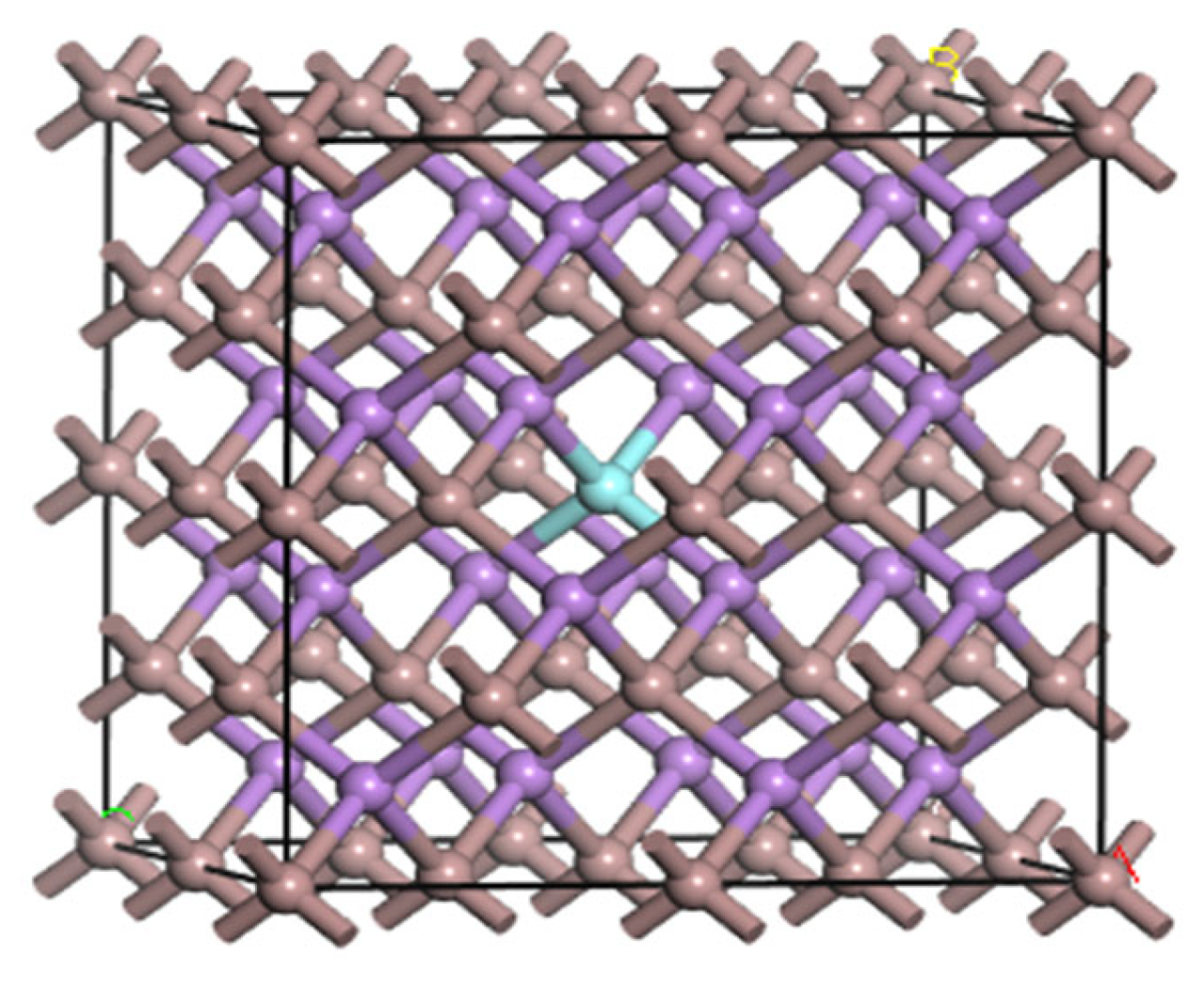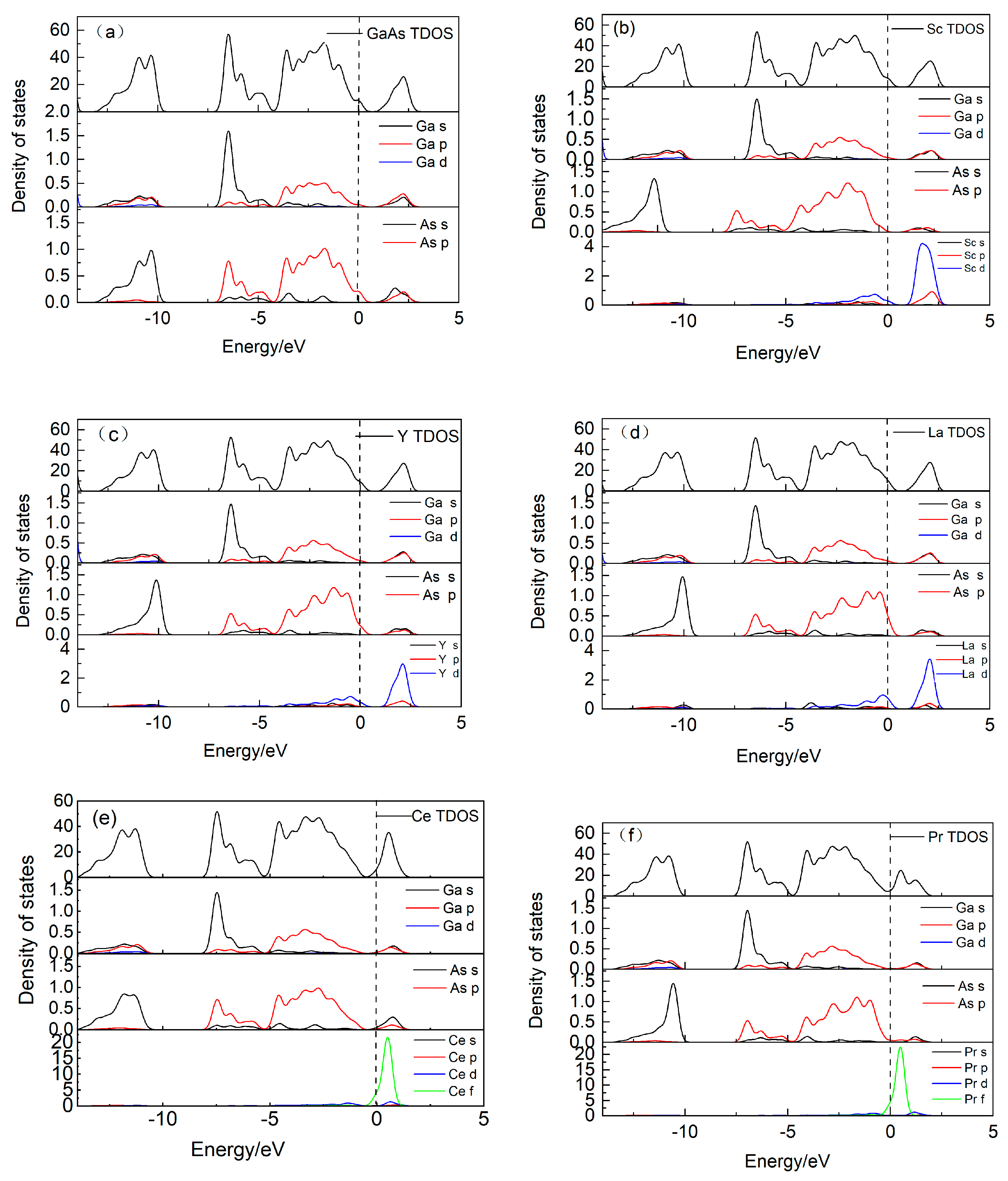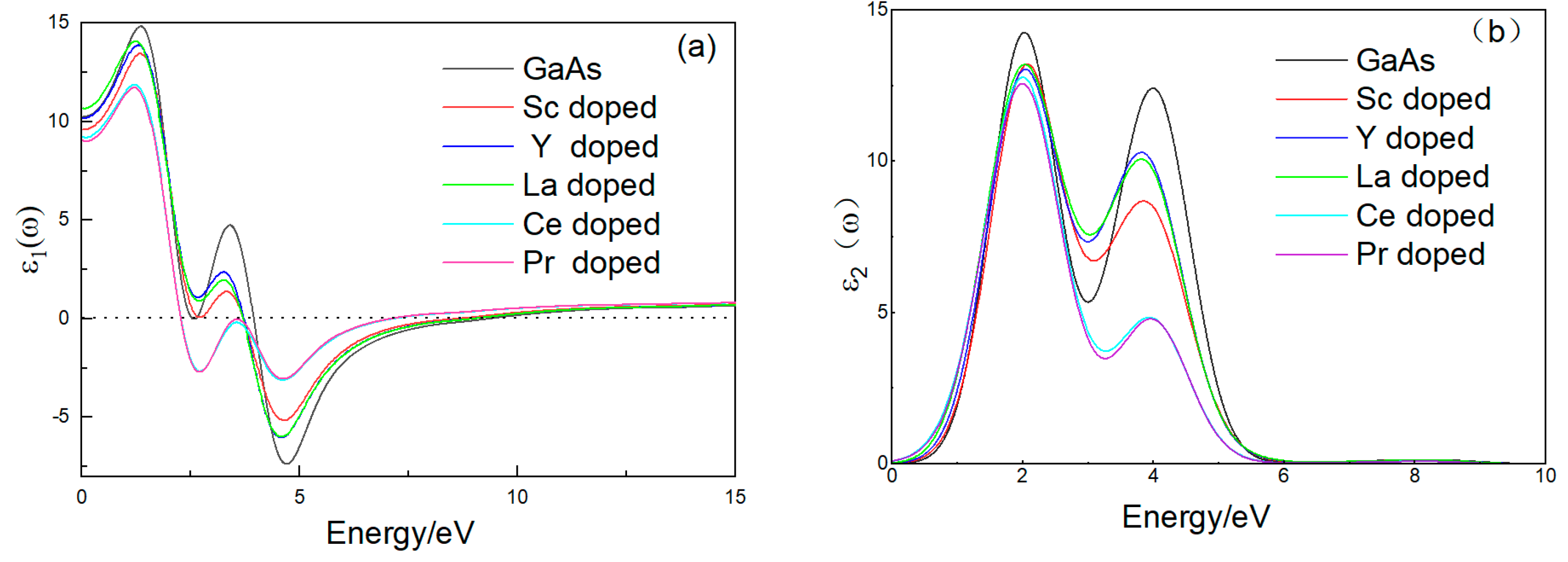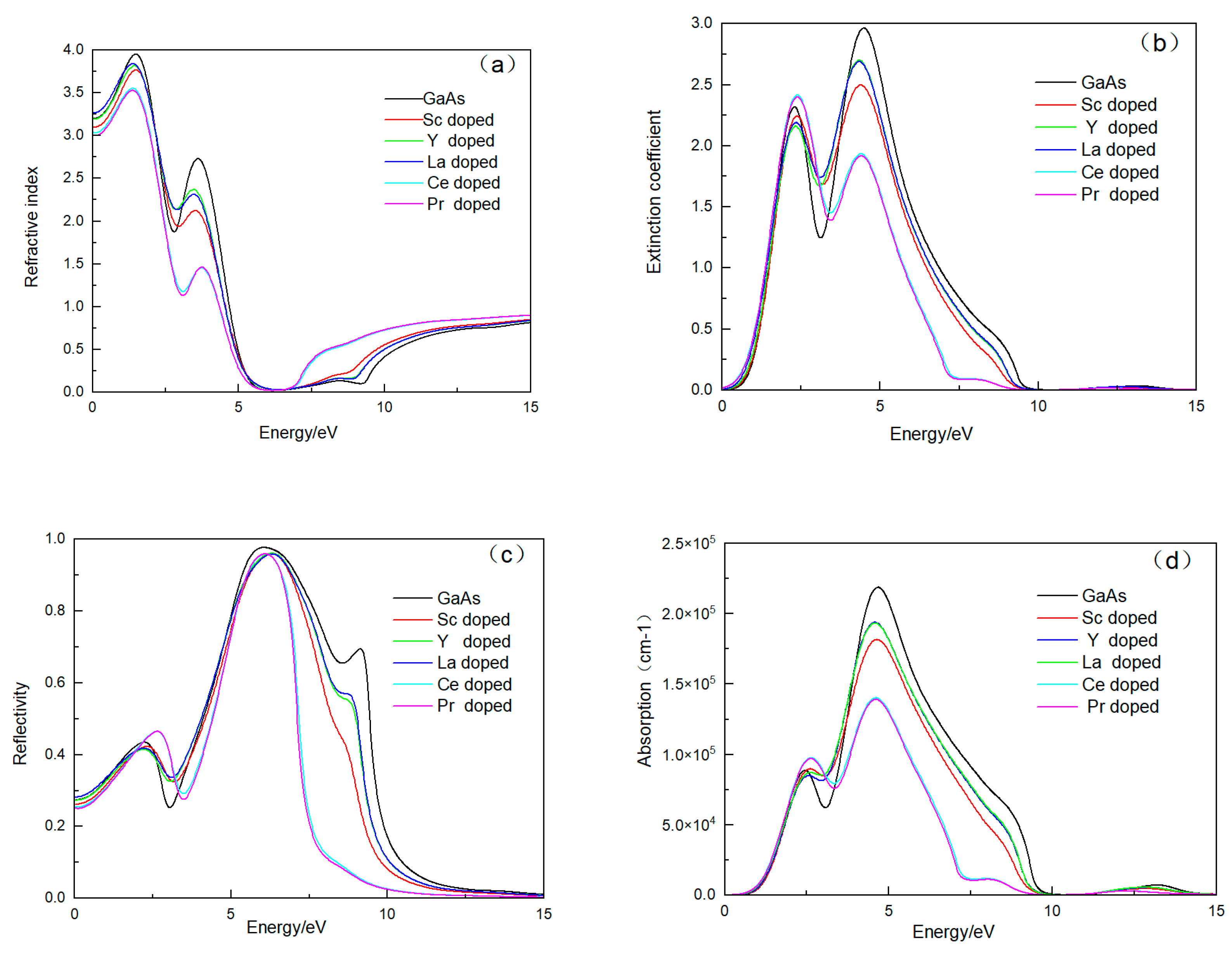Electronic Structure and Optical Properties of GaAs Doped with Rare-Earth Elements (Sc, Y, La, Ce, and Pr)
Abstract
1. Introduction
2. Models and Methods
3. Results and Analysis
3.1. Geometric Structure Optimization
3.2. Band Structure and Density of States
Density of States
3.3. Optical Properties
3.3.1. Dielectric Function
3.3.2. Refractive Index, Reflection Spectrum, and Absorption Coefficient
4. Conclusions
Author Contributions
Funding
Data Availability Statement
Conflicts of Interest
References
- Sze, S.M.; Ng, K.K. Physics of Semiconductor Devices, 3rd ed.; John Wiley and Sons, Inc.: New York, NY, USA, 2007; pp. 197–240. [Google Scholar]
- Nelson, J. The Physics of Solar Cells; Imperial College Press: London, UK, 2003; pp. 177–210. [Google Scholar]
- Attari, K.; Amhaimar, L.; El Yaakoubi, A.; Asselman, A.; Bassou, M. The Design and Optimization of GaAs Single Solar Cells Using the Genetic Algorithm and Silvaco ATLAS. Int. J. Photoenergy 2017, 2017, 8269358. [Google Scholar] [CrossRef]
- Othmani, S.; Ben Ali, I.; Chaaben, N.; Bouzidi, M.; Al Huwayz, M.; Alwadai, N.; Khmissi, H.; Mballo, A.; Vuong, P.; Salvestrini, J.P.; et al. Structural and optical characterizations of cubic GaN layers grown by MOVPE on GaAs(114) substrate. Opt. Mater. 2024, 154, 115644. [Google Scholar] [CrossRef]
- Steiner, M.A.; Geisz, J.F.; García, I.; Friedman, D.J.; Duda, A.; Kurtz, S.R. Optical enhancement of the open- circuit voltage in high quality GaAs solar cells. J. Appl. Phys. 2013, 113, 2546. [Google Scholar] [CrossRef]
- Ren, S.; Zhao, N.; Crawford, S.C.; Tambe, M.; Bulović, V.; Gradečak, S. Heterojunction photovoltaics using GaAs nanowires and conjugated polymers. Nano. Lett. 2011, 11, 408. [Google Scholar] [CrossRef] [PubMed]
- Nakayama, K.; Tanabe, K.; Atwater, H.A. Plasmonic nanoparticle enhanced light absorption in GaAs solar cells. Appl. Phys. Lett. 2008, 93, 2327. [Google Scholar] [CrossRef]
- Saxena, D.; Mokkapati, S.; Parkinson, P.; Jiang, N.; Gao, Q.; Tan, H.H.; Jagadish, C. Optically pumped room-temperature GaAs nanowire lasers. Nat. Photonics 2013, 7, 963–968. [Google Scholar] [CrossRef]
- Zhu, X.; Lin, F.; Zhang, Z.; Chen, X.; Huang, H.; Wang, D.; Tang, J.; Fang, X.; Fang, D.; Ho, J.C.; et al. Enhancing Performance of a GaAs/AlGaAs/GaAs Nanowire Photodetector Based on the Two-Dimensional Electron-Hole Tube Structure. Nano Lett. 2020, 20, 2654–2659. [Google Scholar] [CrossRef]
- Krogstrup, P.; Jorgensen, H.I.; Heiss, M.; Demichel, O.; Holm, J.V.; Aagesen, M.; Nygard, J.; Morral, A.F.I. Single-nanowire solar cells beyond the Shockley-Queisser limit. Nat. Photonics 2013, 7, 306–310. [Google Scholar] [CrossRef]
- Ma, D.; Cao, Y.; Zhang, J.; Deng, Y.; Wang, W.; Li, E. Density functional theory study on the properties of Cu-doped GaAs. Vacuum 2020, 175, 109252. [Google Scholar]
- Xiong, M.Y.; Liu, D.; Luo, L.; Su, X. First Principle study on electronic structures and optical properties of Mn, Fe and Co doped GaAs. J. At. Mol. Phys. 2022, 39, 115–120. [Google Scholar]
- Zhang, Y.; Yang, J.; Zhu, Z.; Zhou, X.; Wu, H.; Tan, M. The study on diluted semiconductors of Mn doped GaAs based on first principles. J. Zhoukou Norm. Univ. 2015, 32, 49–52. [Google Scholar]
- Yu, L.; Li, D.; Zhao, S.; Li, G.; Yang, K. First Principles Study on Electronic Structure and Optical Properties of Ternary GaAs:Bi Alloy. Materials 2012, 5, 2486–2497. [Google Scholar] [CrossRef]
- Guo, S.; Wang, X.; Yu, X.; Su, E.; Li, M.; Zhao, X.; Lei, B.; Zhang, L. First Principles Study on Electronic Structure and Optical Properties of Fe and Sb Doped GaAs. J. Yili Norm. Univ. (Nat. Sci.) 2022, 16, 24–31. [Google Scholar]
- Diao, Y.; Liu, L.; Xia, S.H. Adsorption mechanism of Pt, Ag, Al, Au on GaAs nanowire surfaces from first-principle. J. Phys. Condens. Matter Inst. Phys. J. 2020, 32, 085001. [Google Scholar] [CrossRef]
- Ma, D.; Deng, Y.; Wang, D.; Ji, W.; Li, E. Photoelectricproperties of InXGa1-xAs:A first-principles study. Superlattices Microstruct. 2019, 128, 312–318. [Google Scholar] [CrossRef]
- Paul, S.; Roy, J.B.; Basu, P.K. Emoirical expressions forthe alloy composition and temperture dependence of the bandgap and intrinsic carrier density in InXGa1−xAs. J. Appl. Phys. 1991, 69, 827–829. [Google Scholar] [CrossRef]
- Ma, D.; Deng, Y.; Cao, Y.; Chai, Y.; Li, E.; Yuan, L. The roles of position on the electronic structures, magnetic and optical properties of Cr-doped GaAs. Sixt Symp. Nov. Optoelectron. Detect. Technol. Appl. 2020, 11455, 13. [Google Scholar]
- Wang, X.H.; Cai, X.H.; Wang, Z.J.; Xiong, Q.; Wang, B. Electronic structure of In-doped GaAs Material System By Employing First-principles Calculations. Mod. Appl. Phys. 2023, 14, 196–201. [Google Scholar]
- Su, L.; Wang, X.D.; Yao, M. The First Principles Study on Electronic and Optical of Sb-doped Zinc Blend GaAs. Mater. Rep. 2012, 26, 142–147. [Google Scholar]
- Oe, K.; Okamoto, H. New Semiconductor Alloy GaAs1−xBix Grown by Metal Organic Vapor Phase Epitaxy. Jpn. J. Appl. Phys. 1998, 37, L1283. [Google Scholar] [CrossRef]
- Fluegel, B.; Francoeur, S.; Mascarenhas, A.; Tixier, S.; Young, E.C.; Tiedje, T. Giant Spin-Orbit Bowing in GaAs1-xBix. Phys. Rev. Lett. 2006, 97, 067205. [Google Scholar] [CrossRef] [PubMed]
- Oe, K. Characteristics of Semiconductor Alloy GaAs1−xBix. Jpn. J. Appl. Phys. 2002, 41, 2801. [Google Scholar] [CrossRef]
- Francoeur, S.; Seong, M.-J.; Mascarenhas, A.; Tixier, S.; Adamcyk, M.; Tiedje, T. Band gap of GaAs1−xBix, 0 < x < 3.6%. Appl. Phys. Lett. 2003, 82, 3874. [Google Scholar]
- Tixier, S.; Adamcyk, M.; Tiedje, T.; Francoeur, S.; Mascarenhas, A.; Wei, P.; Schiettekatte, F. Molecular beam epitaxy growth of GaAs1−xBix. Appl. Phys. Lett. 2003, 82, 2245. [Google Scholar] [CrossRef]
- Young, E.C.; Whitwick, M.B.; Tiedje, T.; Beaton, D.A. Bismuth incorporation in GaAs1–xBix grown by molecular beam epitaxy with in-situ light scattering. Phys. Stat. Sol. 2007, 4, 1707. [Google Scholar] [CrossRef]
- Madouri, D.; Boukra, A.; Zaoui, A.; Ferhat, M. Bismuth alloying in GaAs: A first-principles study. Comput. Mater. Sci. 2008, 43, 818–822. [Google Scholar] [CrossRef]
- Kini, R.N.; Ptak, A.J.; Fluegel, B.; France, R.; Reedy, R.C.; Mascarenhas, A. Effect of Bi alloying on the hole transport in the dilute bismide alloy GaAs1−xBix. Phys. Rev. B 2011, 83, 075307. [Google Scholar] [CrossRef]
- Geisz, J.F.; Friedman, D.J.; Olson, J.M.; Kurtz, S.R.; Reedy, R.C.; Swartzlander, A.B.; Keys, B.M.; Norman, A.G. BGaInAs alloys lattice matched to GaAs. Appl. Phys. Lett. 2000, 76, 1443. [Google Scholar] [CrossRef]
- El-Jaroudi, R.H.; McNicholas, K.M.; Bouslog, B.A.; Olivares, I.E.; White, R.C.; McArthur, J.A.; Bank, S.R. Boron alloys for GaAs-based 1.3 μm semiconductor lasers. In Proceedings of the Conference on Lasers and Electro-Optics, San Jose, CA, USA, 5–10 May 2019. [Google Scholar]
- Geisz, J.; Friedman, D.; Kurtz, S.; Olson, J.; Swartzlander, A.B.; Reedy, R.; Norman, A. Epitaxial growth of BGaAs and BGaInAs by MOCVD. J. Cryst. Growth 2001, 225, 372. [Google Scholar] [CrossRef]
- Svane, A.; Christensen, N.E.; Petit, L.; Szotek, Z.; Temmerman, W.M. Electronic structure of rare-earth impurities in GaAs and GaN. Phys. Rev. B 2006, 74, 165204. [Google Scholar] [CrossRef]
- Rzakuliev, N.A.; Konnov, V.M.; Yakimkin, V.N.; Ushakov, V.V.; Gippius, A.A.; Oswald, J.; Pastrňák, J. Luminescence of Pr, Nd and Yb ions implanted in GaAs and GaP. Czech. J. Phys. B 1988, 38, 1288–1293. [Google Scholar] [CrossRef]
- Ennen, H.; Kaufmann, U.; Pomrenke, G.; Windscheif, J.; Axmann, A.J. Rare earth activated luminescence in InP, GaP and GaAs. Cryst. Growth 1983, 64, 165–168. [Google Scholar] [CrossRef]
- Taguchi, A.; Nakagome, H.; Takahei, K.J. Optical and electrical properties of ytterbium-doped GaAs grown by metalorganic chemical vapor deposition. Appl. Phys. 1990, 68, 3390. [Google Scholar] [CrossRef]
- Seghier, D.; Benyattou, T.; Kalboussi, A.; Moneger, S.; Marrakchi, G.; Guillot, G.; Lambert, B.; Guivarc’h, A. Optical and electrical properties of rare earth (Yb, Er) doped GaAs grown by molecular beam epitaxy. J. Appl. Phys. 1994, 75, 4171. [Google Scholar] [CrossRef]
- Burke, P.G.; Ismer, L.; Lu, H.; Frantz, E.; Janotti, A.; Van de Walle, C.G.; Bowers, J.E.; Gossard, A.C. Electrically active Er doping in InAs, In0.53Ga0.47As, and GaAs. Appl. Phys. Lett. 2012, 101, 232103. [Google Scholar] [CrossRef]
- Li, C.; Sun, X.; Yu, M.; Fu, S. First principle study on the photoelectric property of Pr doped GaAs. J. Mudanjiang Coll. Educ. 2014, 4, 96–97. [Google Scholar]
- Zhang, C.-H.; Zhang, Z.-Z.; Deng, Y.-R.; Yan, W.-J.; Zhou, S.-Y. First principle study on photoelectric properties of CdS with doping rare earth (Sc, Y, La). J. SiChuan Univ. (Nat. Sci. Ed.) 2017, 1, 108–114. [Google Scholar]
- Deng, Y.R.; Yan, W.J.; Qin, X.M.; Zhang, C.H.; Zhou, S.Y. Electronic structure and optical properties of rare earth element (La, Y) doped Ca2Si. Laser Optoelectron. Prog. 2018, 60, 0916011-7. [Google Scholar]
- Zhang, C.; Zhang, Z.; Deng, Y.; Yan, W.; Guo, B. First principle study on Electronic structure and optical properties of FeSi2 with doping rare earth (Y, Ce). Acta Opt. Sin. 2015, 1, 0116001. [Google Scholar] [CrossRef]
- Wang, L.; Zhang, J.M.; He, T.; Wang, K.; Xie, Q. First principle study on the effect of the photoelectric properties of (La, Ce)—Doping Mn4Si7. Mater. Res. Express 2019, 6, 096309. [Google Scholar] [CrossRef]
- Zhao, X.; Jin, Y.; Guo, S.; Wei, L.; Zhang, L.; Lei, B. First—Principles study on the effect of lanthanide elements (Ce, Pr, Nd, Sm, Eu) dopants on the photoelectric properties of NaTaO3. Electron. Compon. Mater. 2023, 9, 1094–1101. [Google Scholar]
- Segall, M.D.; Lindan, P.; Probet, M.J.; Pickard, C.J.; Hasnip, P.J.; Clark, S.J.; Payne, M.C. First-principles simulation: Ideas, illustrations and the CASTEP code. J. Phys. Condens Matter. 2002, 14, 2717:1–2717:3. [Google Scholar] [CrossRef]
- Pan, F.; Lin, X.; Cao, Z.; Li, X. Electronic structures and optical properties of Fe, Co, and Nidoped GaSb. Acta Phys. Sin. 2019, 68, 184202. [Google Scholar] [CrossRef]






| Sample | a = b = c (nm) | Volume (nm3) | Total Energy (eV) |
|---|---|---|---|
| Undoped GaAs (experimental) [24] | 0.5653 | 0.1806 | |
| Undoped GaAs (calculated) | 0.5575 | 0.1732 | −71,364.9133 |
| Sc-doped GaAs | 0.5589 | 0.1746 | −70,586.8286 |
| Y-doped GaAs | 0.5602 | 0.1758 | −70,360.2894 |
| La-doped GaAs | 0.5611 | 0.1767 | −70,173.7644 |
| Ce-doped GaAs | 0.5608 | 0.1764 | −70,372.8674 |
Disclaimer/Publisher’s Note: The statements, opinions and data contained in all publications are solely those of the individual author(s) and contributor(s) and not of MDPI and/or the editor(s). MDPI and/or the editor(s) disclaim responsibility for any injury to people or property resulting from any ideas, methods, instructions or products referred to in the content. |
© 2025 by the authors. Licensee MDPI, Basel, Switzerland. This article is an open access article distributed under the terms and conditions of the Creative Commons Attribution (CC BY) license (https://creativecommons.org/licenses/by/4.0/).
Share and Cite
Deng, Y.; Zhang, C.; Qin, X.; Yan, W. Electronic Structure and Optical Properties of GaAs Doped with Rare-Earth Elements (Sc, Y, La, Ce, and Pr). Crystals 2025, 15, 98. https://doi.org/10.3390/cryst15010098
Deng Y, Zhang C, Qin X, Yan W. Electronic Structure and Optical Properties of GaAs Doped with Rare-Earth Elements (Sc, Y, La, Ce, and Pr). Crystals. 2025; 15(1):98. https://doi.org/10.3390/cryst15010098
Chicago/Turabian StyleDeng, Yongrong, Chunhong Zhang, Xinmao Qin, and Wanjun Yan. 2025. "Electronic Structure and Optical Properties of GaAs Doped with Rare-Earth Elements (Sc, Y, La, Ce, and Pr)" Crystals 15, no. 1: 98. https://doi.org/10.3390/cryst15010098
APA StyleDeng, Y., Zhang, C., Qin, X., & Yan, W. (2025). Electronic Structure and Optical Properties of GaAs Doped with Rare-Earth Elements (Sc, Y, La, Ce, and Pr). Crystals, 15(1), 98. https://doi.org/10.3390/cryst15010098







